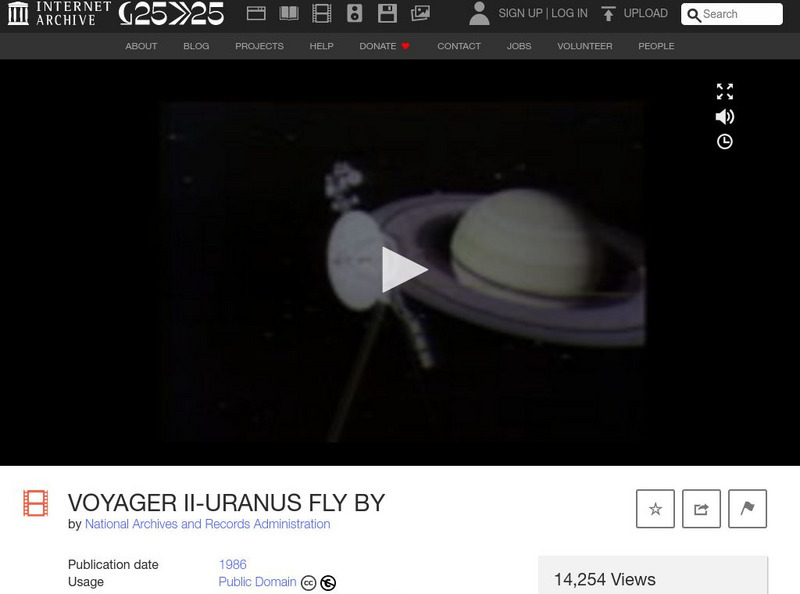Hi, what do you want to do?
Curated OER
Uranus
What makes Uranus unique? Watch this video to discover the planet, its astrological sign, its moons, etc. Note: this film is not narrated; instead, text is shown in front of the picture it describes. Even for a seven-minute video, it's a...
Socratica
The Discovery of Uranus
Take a trip back in time to the Age of Enlightenment. A video lesson describes the sequence of events leading to the discovery of the planet Uranus. Previously, Uranus was considered a faint star, then a comet, and finally correctly...
SciShow
What Knocked Over Uranus? And Two Other Mysteries
It's no secret that most of the galaxy is a mystery. Data suggests that the known exoplanets may be most similar to our own neighborhood planet Uranus. Unfortunately, scientists know little about Uranus. The video lesson presenter...
Crash Course
Uranus and Neptune
Either way you pronounce it, Uranus is one cool planet! An ice giant, to be exact, just like its neighbor, Neptune. Travel to the far reaches of our solar system in a video filled with amazing images and interesting facts. The...
SciShow
Exploring Uranus and Neptune
Could humans survive on Uranus or Neptune? As an installment of a larger solar system series, the video lesson continues in its description of planets in our solar system. A thorough analysis of the two planets describes the physical...
Crash Course Kids
Gas Giants Weather
Jupiter, Saturn, Uranus, and Neptune make up the outer planets. How extreme is the weather on these planets? This is the focus of a video that explains how the gas giants have "crazy storms," strong winds, methane rain, and very cold...
SciShow Kids
Explore the Solar System: The Gas Giants
Take a trip to space's gas giants, also known as the outer planets—Jupiter, Saturn, Uranus, and Neptune—with an interesting video equipped with a spirited host, a cartoon sidekick, and bright, colorful graphics.
SciShow
Why Is Neptune so Blue? and 3 Other Mysteries an Orbiter Could Solve
Neptune appears as a beautiful blue color, but why? Some scientists suggested the methane in the atmosphere gives it that color, but Uranus contains more methane than Neptune. The mystery, along with three others, requires an orbiter to...
SciShow
The Mysterious Origins of Our Galaxy's Fastest Stars
Many phenomena in space are yet beyond scientific explanation. An episode of a video series on the solar system discusses two recent topics of interest: Uranus' magnetic field and hypervelocity stars. The presenter explains what we know...
SciShow
3 of the Strangest Moons in the Solar System
Explore characteristics of three moons that have traits all their own! An episode of a solar system video playlist explores three moons of the solar system: Miranda, Iapetus, and Hyperion. These moons of Uranus and Saturn vary in their...
Coloring Castle
Planets
From Mercury to Uranus, this printable coloring page includes images of all eight planets found in our solar system, making it a fun way to engage young scientists in learning about outer space.
Crash Course Kids
Seeing Stars
What are all those shiny things we see in the sky at night? It could be a star, planet, or asteroid! This is the focus of a video that helps viewers distinguish between these three objects in the sky.
SciShow Kids
Let's Make the Solar System
Get crafty with the help of pictures and a real-time demonstration from a video that details the step-by-step process in creating a paper solar system.
PBS
The Sun and Planets
Do other planets experience night, day, and the seasons like humans do here on Earth? Examine planetary motion using real images of the planets through a simulation from PBS's Space lesson series. After observing the motion of each...
SciShow
Gravitation: The Four Fundamental Forces of Physics #3
The Newtonian theory and the Einstein theory of gravity are the focus of a video that examines the details of each and includes the drawbacks of them as well — a great, well-rounded lesson!
PBS
Pbs Learning Media: Crash Course Astronomy: Uranus & Neptune
We complete our planetary tour with a review of the ice giants Uranus and Neptune. Both have small rocky cores, thick mantles of ammonia, water, and methane, and atmospheres that make them look greenish and blue. Uranus has a truly weird...
US National Archives
National Archives: Voyager Ii Uranus Fly By
National Archives video [28:06] discussion of the discovery of new moons and facts discovered about Uranus.
Crash Course
Crash Course Astronomy #19: Uranus and Neptune
Today we're rounding out our planetary tour with ice giants Uranus and Neptune. Both have small rocky cores, thick mantles of ammonia, water, and methane, and atmospheres that make them look greenish and blue. Uranus has a truly weird...
SciShow
Sci Show Kids: Explore the Solar System: The Gas Giants
Take a tour of the gas giants and learn important facts about these planets. Understand that Jupiter has a giant storm called Great Red Spot, Saturn has the biggest and brightest rings, how Uranus spins on its side, and Neptune's storms...
Crash Course
Crash Course Kids 43.2: Gas Giants Weather
In this episode of Crash Course Kids, Sabrina takes leads a virtual tour of the Gas Giants and shows what kind of weather happens on those planets. [4:42]
NASA
Nasa: Galleries: Video: What Is a Planet?
Explanation of the characteristics an object must have to be considered a planet. [7:53]
Other
#Ask Mit: Why Are Gas Giants Round?
Find out professor Anna Frebel's answer to the question, "How come our gas giants stay in a sphere, instead of the gas just floating around everywhere in space?" [3:29]
Other popular searches
- Saturn and Uranus
- Uranus and Neptune
- Uranus Planet
- Closest Planet to Uranus
- Uranus Video
- 15 Moons of Uranus
- Imf on Uranus
- Uranus in Greek Mythology
- Imfo on Uranus
- Uranus Colour
- Uranus Co Lour
- Uranus Distance From Sun

























